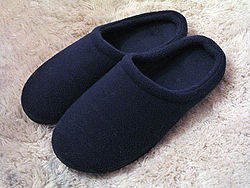| Revision as of 16:02, 5 January 2008 editKencf0618 (talk | contribs)Extended confirmed users, New page reviewers21,901 edits Style; Japanese & Western footwear customs; multiple citations needed.← Previous edit | Revision as of 21:28, 5 January 2008 edit undoSmackBot (talk | contribs)3,734,324 editsm Date/fix the maintenance tags or gen fixes using AWBNext edit → | ||
| Line 32: | Line 32: | ||
| == Use by The ] == | == Use by The ] == | ||
| ] wears scarlet red leather slippers with white socks. Contrary to initial speculation, the Vatican has announced{{ |
] wears scarlet red leather slippers with white socks. Contrary to initial speculation, the Vatican has announced{{Fact|date=January 2008}} that the loafers are not made by ] –they are provided by the pope's personal cobbler. | ||
| ==Homonyms== | ==Homonyms== | ||
Revision as of 21:28, 5 January 2008
For the hip hop producer, see DJ House Shoes. For the Australian politician, see Peter Slipper.
A slipper, also called a houseshoe, is a soft and lightweight indoor type of casual footwear.
Domestic Footwear Customs

The word is recorded in English in 1478, deriving from the much older verb to slip, the notion being of footwear that is "slipped" onto the foot. Slippers are frequently made out of soft materials such as felt, terrycloth or soft leather, and may or may not be lined. Some slippers, particularly those meant to be used near pools, bathrooms, or other wet places, are made of plastic or rubber. Slippers generally have thin and flexible soles, with a shallow tread meant only to prevent the wearer from slipping on smooth floors. In contrast, shoes and boots are generally made of canvas, plastic, rubber, or leather, and often have thick soles.
Slippers may be shaped like a shoe (foot inserted through top), or may have no heel, so the foot can be slipped in the back.
Slippers now come in many colourful designs –cartoon characters, patterns and animals are often used to decorate this type of footwear.
In Japan, one type of modern slipper evolved from those made during the Meiji period (1868 to 1912). The Japanese were accustomed to taking off their shoes before entering their homes and donning slippers at the threshold – this was not the case for western cultures, where customs regarding domesticity differed and slippers were mainly worn by a home's residents in the evening. For the Japanese it was problematic for foreigners who did not know or follow their customs to enter homes with their shoes on. Thus, special slippers were made {{citation}}: Empty citation (help) for the foreigners to pull over their shoes in order to keep the indoors sanitary. Such slippers are in widespread use in Japan today by citizenry and gaijin alike. {{citation}}: Empty citation (help)
Slippers also evolved much earlier in India. A Southern Song dynasty officer Zhou Qu Fei(1135-1189),stationed in Quanxi province of China, described two types of slippers he saw in Jiaozhi (now Vietnam) in his 1178 book "Ling Wai Dai Da", both types of slippers had leather bottom, one type has a small post about an inch long with a a mushroom shape top up front, people wore this slipper by holding the post between their toes; another type of slipper had a cross shape leather cover across the top of the leather bottom, Zhou noted that these slipper looked exactly like the slippers on the feet of arhats in some paintings. He noted further that the people of Kulam in Southern India wore a kind of red slipper which looked exactly like the slipper of arhats in painting.
Nicknames
The term "slipper" is sometimes used interchangeably with the terms flip-flop and sandal. This is especially true where footwear is not customarily worn indoors; in the Philippines, India and Hawaii the word "slipper" generally refers to the sandal or flip-flop. This term can be used for sandals or flip-flops even though it is not truly "correct" per sey.
In Scotland, especially on the east coast, they are often called "baffies". This is thought to derive from the Scots word 'bachle' meaning to shuffle.
The fictional character Cinderella is said to have worn glass slippers; in modern parlance they would probably be called glass mules.
Derek "The Slipper Man" Fan holds the Guinness Book of World Records for wearing a pair of dress slippers for 23 years straight as of June 30th, 2007.
Use by The Pope
Pope Benedict XVI wears scarlet red leather slippers with white socks. Contrary to initial speculation, the Vatican has announced that the loafers are not made by Prada –they are provided by the pope's personal cobbler.
Homonyms
- In hare coursing, a slipper is a person who "slips" or releases dogs to chase the hare. Slippers are registered and trained by the British NCC (National Coursing Club), but coursing is controversial and becoming banned in most countries due to its allegedly inhumane treatment of the hare.
- In Dutch, the word slipper used in its diminutive form 'slippertje' denotes an amorous affair which a married person 'slips' into. The Dutch word may also mean a (plastic) slipper used in humid areas (unlike ordinary slippers)
- Zhou Qu Fei: Ling Wai Dai Da, Vol 6, section 106" Leather slippers ISBN 7101016650
- Zhou Qu Fei: Ling Wai Dai Da, vol 2 section 37 :Kulam ISBN 7101016650
 This article incorporates text from a publication now in the public domain: Chisholm, Hugh, ed. (1911). Encyclopædia Britannica (11th ed.). Cambridge University Press.
This article incorporates text from a publication now in the public domain: Chisholm, Hugh, ed. (1911). Encyclopædia Britannica (11th ed.). Cambridge University Press. {{cite encyclopedia}}: Missing or empty|title=(help)- EtymologyOnLine- click also on the link to the verb slip